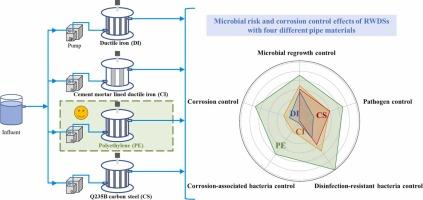Pipe material significantly affected microbial regrowth and potential risks in reclaimed water distribution systems
IF 11.3
1区 环境科学与生态学
Q1 ENGINEERING, ENVIRONMENTAL
引用次数: 0
Abstract
Secondary pollution and microbial risks pose significant challenges to reclaimed water distribution systems (RWDSs). This study conducted 140 d investigations on temporal variations in water characteristics, microbial regrowth and communities in RWDSs with different pipe materials, including ductile iron (DI), cement mortar lined ductile iron (CI), polyethylene (PE), and Q235B carbon steel (CS). It was demonstrated that microbial community was significantly influenced by bacterial phase. Candidatus_Kaiserbacteria, Legionella and Mycobacterium were relatively abundant in bulk water and effluent, while Hyphomicrobium, Gordonia, and Sphingobium were significantly enriched in pipe-wall biofilms. With respect to the influences of pipe materials, PE system demonstrated superior performance in microbial regrowth control and water quality maintenance compared to DI, CI, and CS systems. The relative abundances of pathogens and disinfection-resistant bacteria in PE system were significantly lower, and corrosion-associated bacteria were markedly abundant in DI and CS systems. These results demonstrated lower potential microbial risks and higher practical advantages of PE pipe. Redundancy analysis and Mantel test revealed microbial communities correlated well with extracellular polymeric substances and reclaimed water characteristics (p < 0.05). This study provided valuable insights into microbial risk control and pipe material selection for safer wastewater reclamation.

管道材料显著影响再生水分配系统中微生物的再生和潜在风险
二次污染和微生物风险是中水分配系统面临的重大挑战。本研究对采用球墨铸铁(DI)、水泥砂浆内衬球墨铸铁(CI)、聚乙烯(PE)和Q235B碳钢(CS)等不同管道材料的rwds进行了为期140 d的水特征、微生物再生和群落变化研究。结果表明,菌相对微生物群落有显著影响。原水和出水中Candidatus_Kaiserbacteria、Legionella和Mycobacterium相对丰富,管壁生物膜中菌丝微生物(Hyphomicrobium)、Gordonia和Sphingobium显著富集。在管材影响方面,PE体系在控制微生物再生和维持水质方面表现优于DI、CI和CS体系。PE系统中病原菌和耐药菌的相对丰度明显较低,而DI和CS系统中腐蚀相关菌的相对丰度明显较高。这些结果表明PE管具有较低的潜在微生物风险和较高的实用优势。冗余分析和Mantel检验显示,微生物群落与细胞外聚合物物质和再生水特性相关良好(p<0.05)。该研究为微生物风险控制和管道材料的选择提供了有价值的见解。
本文章由计算机程序翻译,如有差异,请以英文原文为准。
求助全文
约1分钟内获得全文
求助全文
来源期刊

Journal of Hazardous Materials
工程技术-工程:环境
CiteScore
25.40
自引率
5.90%
发文量
3059
审稿时长
58 days
期刊介绍:
The Journal of Hazardous Materials serves as a global platform for promoting cutting-edge research in the field of Environmental Science and Engineering. Our publication features a wide range of articles, including full-length research papers, review articles, and perspectives, with the aim of enhancing our understanding of the dangers and risks associated with various materials concerning public health and the environment. It is important to note that the term "environmental contaminants" refers specifically to substances that pose hazardous effects through contamination, while excluding those that do not have such impacts on the environment or human health. Moreover, we emphasize the distinction between wastes and hazardous materials in order to provide further clarity on the scope of the journal. We have a keen interest in exploring specific compounds and microbial agents that have adverse effects on the environment.
 求助内容:
求助内容: 应助结果提醒方式:
应助结果提醒方式:


